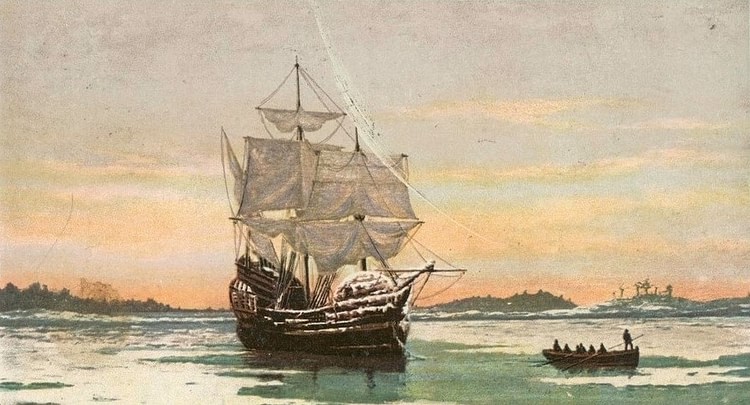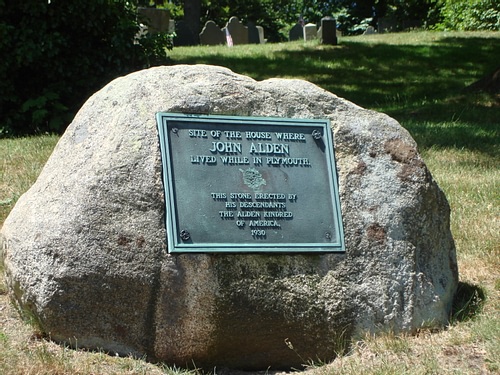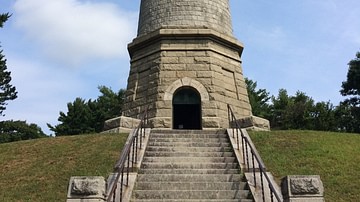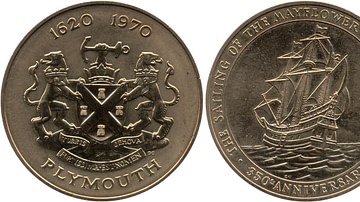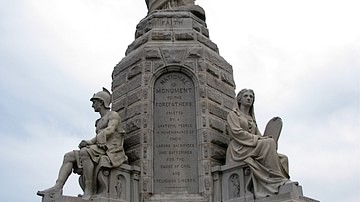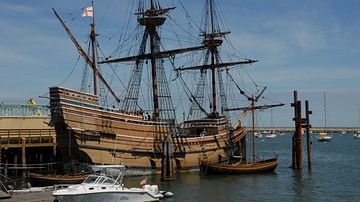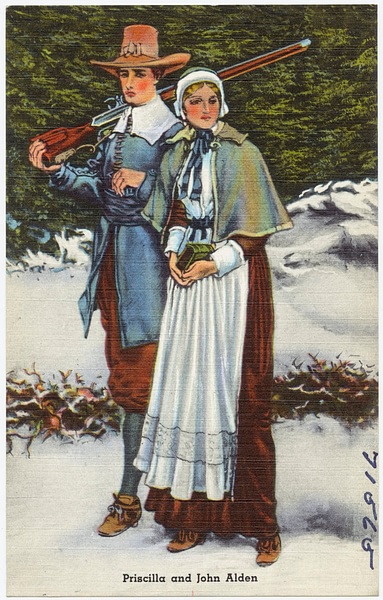
John Alden (l. c. 1598-1687 CE) was a member of the crew of the Mayflower, serving as the ship's cooper (barrel maker), on the historic voyage of 1620 CE which established the Plymouth Colony in Massachusetts, North America. Although he was only contracted for services to the ship, he elected to remain with the passengers of the Mayflower once they reached land and helped to build the settlement, later becoming one of its more prominent members, serving as assistant to the governor, and participating in the founding of the nearby settlement of Duxbury, Massachusetts.
Alden is among the better-known colonists owing to the 1858 CE historical fiction The Courtship of Miles Standish by the American poet Henry Wadsworth Longfellow (l. 1807-1882 CE) which features him as a central character in a love triangle with Captain Myles Standish (l. c. 1584-1656 CE) and Priscilla Mullins (l. c. 1602-1685 CE). Longfellow was one of their descendants and claimed that his poem was based on family history, which it may be so, but modern-day scholars have generally concluded the story of Alden serving as a middleman in a courtship of Mullins by Standish is fiction. Even so, the poem was immensely popular and established itself firmly in the national consciousness of the United States, influencing the wider adoption of the holiday of Thanksgiving in 1863 CE and afterwards.
Besides his role in Longfellow's poem and subsequent depiction in artworks based on it, Alden is remembered as one of the signers of the Mayflower Compact and the last one living in 1687 CE, the year of his death. He and his wife Priscilla continue to generate considerable interest in the present day and the site of his home in Duxbury, as well as that of his son, Captain Jonathan Alden, Sr. (l. c. 1632-1697 CE), are maintained as historic sites by their descendants and later admirers, the Alden Kindred of America.
Early Life & Mayflower
Alden's origins are unknown, although many scholars have offered theories as to his heritage, with the general consensus settling on the Alden family of Harwich, England. William Bradford (l. c. 1590-1657 CE), the second governor of Plymouth Colony who wrote an early account of the settlement, Of Plymouth Plantation, only says that he and the other passengers met Alden at Southampton when they met the Mayflower. Scholars have noted that this passage should not be interpreted to mean Alden came from Southampton since it seems clear he would have been there as a member of the Mayflower crew, not necessarily as a citizen.
Bradford's description of him from Of Plymouth Colony only gives the briefest details:
John Alden was hired at Southampton as a cooper. Being a likely young man, he was desirable as a settler; but it was left to his own choice to stay here or return to England; he stayed, and married Priscilla Mullins. (Book II. ch. 26)
After Longfellow's poem made Alden a household name, however, fuller descriptions were given, including his physical appearance which is nowhere mentioned in the original documents of the colony. The popular work Saints and Strangers by George F. Willison (published in 1945 CE) follows the model which seems to have been established after Longfellow's work:
John Alden was a “hopeful young man” of twenty from Harwich, Essex. His children remembered him as tall, blond, and very powerful in physique, one of the strongest men at Plymouth, qualities very useful in a hired man, as the company no doubt recognized in signing him up as such under a contract. (131)
He would have been around the age of 21 when he was hired by Christopher Jones, Captain of the Mayflower (l. c. 1570-1622 CE), to whom he may have been related. Jones was hired by the merchant adventurer Thomas Weston (l. 1584 - c. 1647 CE) who had put together a deal between the Virginia Company of London and a congregation of religious separatists, previously of Scrooby, England, who had fled to Leiden, the Netherlands to escape persecution by King James I of England (r. 1603-1625 CE), head of the Anglican Church. The separatists objected to many of the beliefs, practices, and policies of the Anglican Church and so formed their own congregations with their own rules. King James I interpreted their criticism of his church as treason against the crown and prosecuted cases against them accordingly.
Leiden Congregation & Voyage
The Leiden congregation had left Scrooby after they had been discovered and a number of them arrested in 1607 CE and had lived in the Netherlands in relative safety until one of their members, William Brewster (l. 1568-1644 CE), published a tract critical of the Anglican Church in 1618 CE and orders were issued for his arrest. The separatists stepped up their efforts to leave Europe for the so-called New World, and through the efforts of two of their members – Robert Cushman (l. 1577-1625 CE) and John Carver (l. 1584-1621 CE) – secured the deal with Weston to make this happen.
Weston originally agreed to transport the congregation alone on a passenger ship, the Speedwell, which they furnished, and a cargo ship, the Mayflower, which Weston had rented. Weston changed the deal with Cushman, however, prior to their departure, now stipulating that a number of passengers who were not of the Leiden congregation's faith would be accompanying them to ensure the establishment of a profitable colony. These Strangers (as the separatists called them) were, for the most part, also met at Southampton just prior to departure.
The two ships left together in July of 1620 CE, but the Speedwell leaked and, after having to return to land twice for repairs, was abandoned. Some of the Speedwell's passengers then boarded the Mayflower, and the transatlantic voyage began again on 6 September 1620 CE. Willison characterizes Alden's place among them as making sure their stores were intact by tending to the containers:
A cooper by trade, he was now carefully tending the Pilgrims' precious barrels of beer, plain water, and “strong water” which took up much space in the hold…Alden had plenty to do keeping the barrels tight and sampling them occasionally to see that air was not getting in to spoil the contents. (131)
After a rough voyage of over two months at sea, during which two people died and the central beam of the ship cracked (which Alden most likely helped repair along with the ship's carpenter), land was sighted on 9 November 1620 CE. The Mayflower had been blown far off course, however, and instead of landing in Virginia – where they held a legal patent to establish a colony – they found themselves off Cape Cod, Massachusetts.
Mayflower Compact & First Winter
Their location posed a number of problems, but the most immediate was called to their attention when a number of the Strangers on board pointed out that, since they were not in Virginia, they were no longer under English law, and would live as they pleased once they were ashore. This dispute led to the composition of the Mayflower Compact, a document establishing a democratic form of government for the new colony, to replace the patent which stipulated the colonists live under the law. Bradford writes:
It was believed by the leading men among the settlers that such a deed, drawn up by themselves, considering their present condition, would be as effective as any patent and, in some respects, more so. (Book II. ch. 1)
On 11 November 1620 CE, 41 of the men aboard the Mayflower signed the compact, including Alden (the youngest signer), agreeing to abide by the laws set down. The agreement was inspired by, and based on, the covenant of the Leiden congregation written by their pastor John Robinson (l. 1576-1625 CE), who did not accompany them on the voyage, but provided for a vote and a voice for any freeman over the age of 21 in the colony, regardless of religious belief. That Alden signed the document means he must have been at least 21 years old at that time and, further, that he had already decided to remain with the colonists instead of returning to England on the Mayflower.
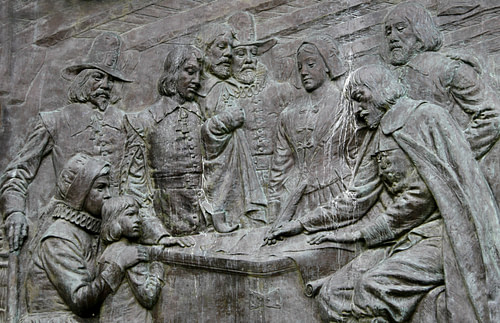
After the compact was signed, Carver was elected the first governor of the colony, and an expedition was launched for shore. Alden may have participated in the earliest of these, which went in search of a place to settle, and also later expeditions led by Captain Jones for supplies and provisions. Explorations, using the small boats they had brought, went on until 21 December 1620 CE when they selected the spot which would become Plymouth Colony. Between December 1620 and March 1621 CE, however, over half the passengers and crew would die of various ailments ranging from scurvy to exposure, and among these would be the entire family of the young Priscilla Mullins.
The Courtship of Miles Standish
William Mullins (l. c. 1572 - winter of 1620/1621 CE) was a shoemaker and merchant from Surrey, England who traveled with his wife Alice, son Joseph, daughter Priscilla, and servant Robert Carter. The family was Anglican and so were part of the Stranger contingent of the passengers. William Mullins was financially well-off and thought to establish an outlet for his sales in the New World, traveling with over 200 pairs of shoes he planned on selling once they reached Virginia. He and his wife and son would not survive the first winter, however, leaving Priscilla alone. His will, witnessed by Captain Jones and John Carver, make clear that he left her a sizeable inheritance.
The surviving passengers, both Saints and Strangers, (later known as pilgrims from a line in Bradford's book) continued to struggle through March 1621 CE until they were helped by the Native Americans of the region, especially Tisquantum (better known as Squanto, l. c. 1585-1622 CE), who spoke English and, by the direction of Ousamequin (the chief Massasoit, l. c. 1581-1661 CE), taught them how to cultivate crops, fish, and hunt. Shortly after their meeting, which had been first initiated by the native Samoset (also given as Somerset, l. c. 1590-1653 CE), a treaty was signed between the Native Americans of Massasoit's Wampanoag Confederacy and the colonists, guaranteeing peace and mutual aid.
As more colonists arrived in 1621 CE, however, this relationship was strained as the neighboring colony of Wessagusset did not honor the treaty and, being poorly provisioned, regularly stole supplies from the Native Americans. Tensions eventually rose, and Massasoit warned the pilgrims of Plymouth of a planned attack on both settlements by the tribe of the Massachusetts. Longfellow's famous poem of the love triangle between Alden, Standish, and Priscilla Mullins is set against this background. The poem compresses time and takes some license with historical fact in presenting what has easily become the most famous story of the Plymouth Colony, whether the events depicted ever happened or not.
Longfellow, a descendant of John and Priscilla, claimed he was relating family history. This could certainly be true as many families have their legends which are passed down through the generations as fact, but, even so, there is no objective evidence to support his claim. It is generally thought that the poet simply found in his ancestors the inspiration for a compelling story and wove a romantic tale around them in which Alden and Standish are roommates at Plymouth (as they probably were in fact) both in love with Priscilla, the only eligible young woman available. Standish's wife, Rose, had died during the previous winter, and Alden was unmarried.
According to the poem, the rough soldier Standish lacked confidence in courting Priscilla as he had no gift of “flowery speech” to make his feelings known. He, therefore, asked Alden to speak on his behalf but Alden's true feelings for Priscilla were revealed while he was trying to make the match, and Priscilla, who is depicted as being in love with Alden from the beginning of the poem, thinks Alden is only pretending to deliver messages from Standish to protect himself from rejection and tells him to speak honestly for himself. Once he does, the two become a couple and Standish feels betrayed by his friend.
Standish leaves to lead a raid on the Native Americans who are about to attack Wessagusset while John and Priscilla prepare for their marriage. Prior to their wedding day, word reaches the settlement that Standish may have died in the raid, but as the wedding concludes, he returns to congratulate the couple, and the poem ends happily with the three of them reconciled as the bridal procession walks through town.
In reality, Alden and Priscilla were about the same age and most likely attracted to each other, with no evidence of Standish having anything to do with their relationship. Nothing is known of their courtship, and there is no mention in any records of a love triangle anywhere outside of Longfellow's work. John and Priscilla were married c. 1622 CE and would have ten children. John was an active participant in the colony's government, serving as assistant to Bradford as well as the third governor Edward Winslow (l. 1595-1655 CE). He also took on a number of other community-related responsibilities, without pay, but the couple and their children were able to live comfortably owing to Priscilla's inheritance and John's monopoly of the fur trade.
Conclusion
In 1626 CE, Alden was among the leading members of the colony to take on the debt which they still owed to the Virginia Company for the expedition of 1620 CE. In exchange, he was given control of the fur trade, which, by that time, had become quite lucrative. In 1634 CE, a man named John Hocking, from another colony, was killed by a member of the Plymouth Colony in a dispute over trade, and Alden, traveling on a trading mission to Boston, was arrested even though he had not been party to the shooting. Bradford intervened, claiming that the colony at Boston had no right to hold a citizen of Plymouth, and Alden was freed. This event would influence the laws later governing the colonies collectively which, up to this point, considered themselves separate political entities. Winslow contributed to the Articles of Confederation of New England, establishing a collective government and laws which Alden's arrest had made necessary.
Bradford allocated land around Plymouth for its citizens to cultivate as more colonists arrived, and Plymouth Colony developed further. A number of the early arrivals, including Alden and Standish, submitted petitions in 1628 CE to establish their own parcels away from the town which was now becoming overcrowded. They founded the village of Duxbury, but because they were required to attend church services in Plymouth, they had to travel the ten miles and back every Sunday, necessitating a home at Plymouth during winter months when travel was difficult, and only living at Duxbury the rest of the year. This travel eventually became tiresome, and in 1632 CE, Alden petitioned for the establishment of a separate church in Duxbury with its own minister, which led to the incorporation of the town in 1637 CE.
Alden died of natural causes on 12 September 1687 CE at his home in Duxbury and was buried in the Old Burying Ground under a marker which was later lost. As noted, John and Priscilla were immortalized in Longfellow's poem in 1858 CE and, afterwards, only grew in mythic stature. In 1906 CE, the group known as the Alden Kindred of America was formed to maintain their legacy, and in 1930 CE, they sponsored the placement of monuments at the sites believed to be the graves of John and Priscilla Alden. Artifacts from the original Alden home at Duxbury, as well as the later home built by one of their sons, are on display at the Pilgrim Hall Museum in Massachusetts, USA, and the Alden family continues to be honored for their contribution to the establishment of the early settlements of what would become the United States of America.
